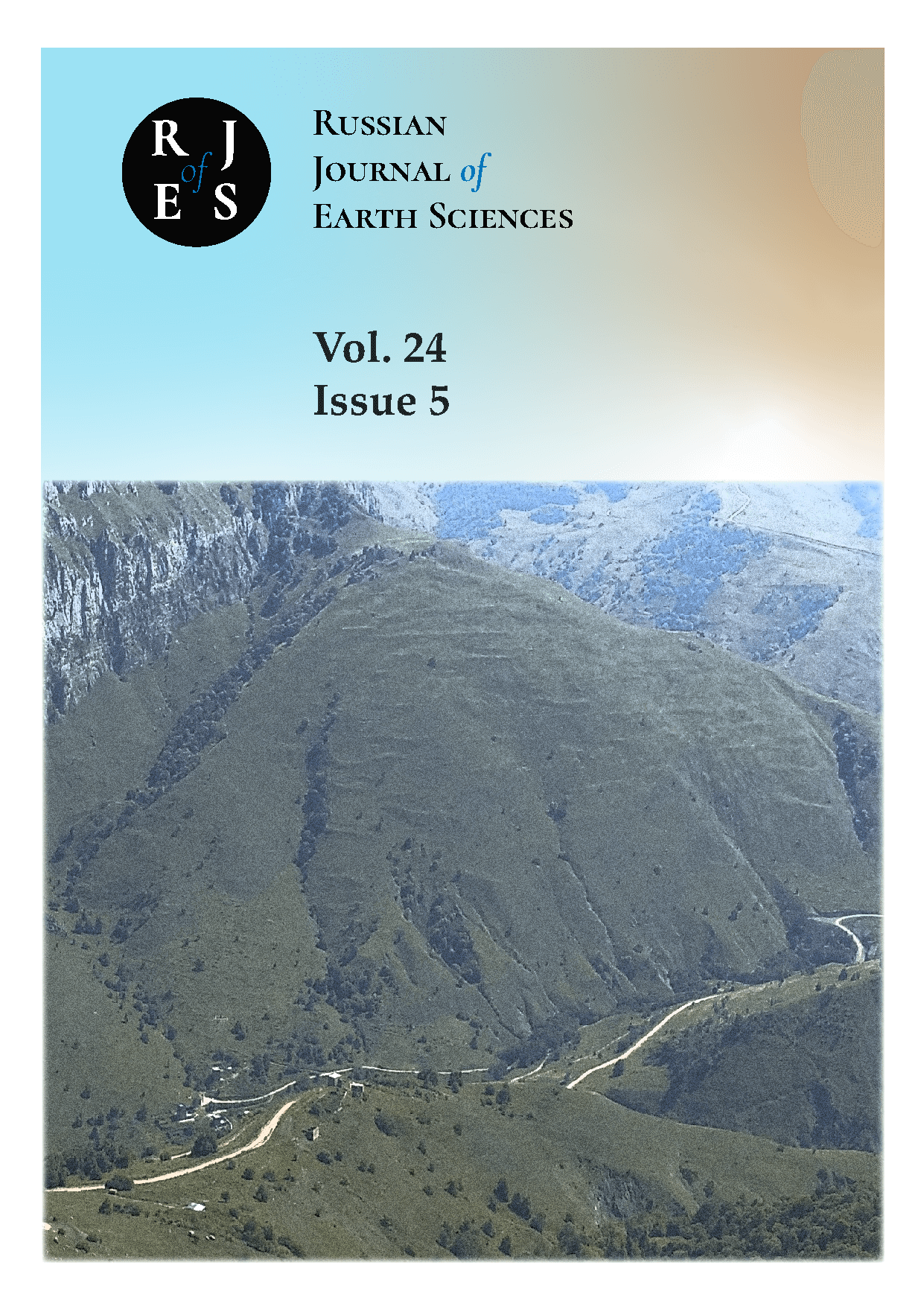from 01.01.2022 to 01.01.2024
Jeddah, Saudi Arabia
Jeddah, Saudi Arabia
Jeddah, Saudi Arabia
Jakarta, Indonesia
UDC 55
UDC 550.34
UDC 550.383
CSCSTI 37.01
CSCSTI 37.15
CSCSTI 37.25
CSCSTI 37.31
CSCSTI 38.01
CSCSTI 36.00
CSCSTI 37.00
CSCSTI 38.00
CSCSTI 39.00
CSCSTI 52.00
Russian Classification of Professions by Education 05.00.00
Russian Classification of Professions by Education 21.00.00
Russian Library and Bibliographic Classification 26
Russian Trade and Bibliographic Classification 63
BISAC SCI SCIENCE
The remote sensing analysis within the Hu'u District area is known to face a challenge with dense vegetation. The problem affects the accurate reading of spectral reflectance from satellites, influencing the differentiation between potential mineral zones and vegetation. Therefore, this study aims to carry out a remote sensing analysis of densely vegetated areas to differentiate minerals from vegetation and obtain potential mineral zones. The combination band ratios and principal component analysis (PCA) methods are used to acquire potential mineral zones. Furthermore, Landsat 8 images freely available on Google Earth Engine are adopted and the validation is carried out using a drill hole from previous study. The results show that band ratios method cannot distinguish mineral zones from vegetation. However, PCA method can recognize potential mineral zones. This is the result from PCA method with band combination of bands 1, 2, 3, 4, 5, and 6 as the first group and band 2, 4, 5, and 6 as the second group.
Landsat 8, Band Ratio, Principal Component Analysis, Mineral, Densely Vegetated Areas
1. Aita, S. K., and A. E. Omar (2021), Exploration of uranium and mineral deposits using remote sensing data and GIS applications, Serbal area, Southwestern Sinai, Egypt, Arabian Journal of Geosciences, 14(21), https://doi.org/10.1007/s12517-021-08568-0. EDN: https://elibrary.ru/GGYZDW
2. Bakardjiev, D., and K. Popov (2015), ASTER spectral band ratios for detection of hydrothermal alterations and ore deposits in the Panagyurishte Ore Region, Central Srednogorie, Bulgaria, Review of the Bulgarian Geological Society, 76(1), 79–88.
3. Burrows, D. R., M. Rennison, D. Burt, and R. Davies (2020), The Onto Cu-Au Discovery, Eastern Sumbawa, Indonesia: A Large, Middle Pleistocene Lithocap-Hosted High-Sulfidation Covellite-Pyrite Porphyry Deposit, Economic Geology, 115(7), 1385–1412, https://doi.org/10.5382/econgeo.4766. EDN: https://elibrary.ru/ITWCFE
4. Carranza, E. J. M., and M. Hale (2002), Mineral imaging with Landsat Thematic Mapper data for hydrothermal alteration mapping in heavily vegetated terrane, International Journal of Remote Sensing, 23(22), 4827–4852, https://doi.org/10.1080/01431160110115014.
5. Chen, Q., Z. Zhao, J. Zhou, et al. (2021), New Insights into the Pulang Porphyry Copper Deposit in Southwest China: Indication of Alteration Minerals Detected Using ASTER and WorldView-3 Data, Remote Sensing, 13(14), 2798, https://doi.org/10.3390/rs13142798. EDN: https://elibrary.ru/SNFZNM
6. Fadlin, R. Takahashi, A. Agangi, et al. (2023), Geology, mineralization and calcite-rich potassic alteration at the Humpa Leu East (HLE) porphyry Cu-Au prospect, Hu’u district, Sumbawa Island, Indonesia, Resource Geology, 73(1), https://doi.org/10.1111/rge.12309.
7. Ghasemi, K., B. Pradhan, and R. Jena (2018), Spatial Identification of Key Alteration Minerals Using ASTER and Landsat 8 Data in a Heavily Vegetated Tropical Area, Journal of the Indian Society of Remote Sensing, 46(7), 1061–1073, https://doi.org/10.1007/s12524-018-0776-0.
8. Hede, A. N. H., K. Kashiwaya, K. Koike, and S. Sakurai (2015), A new vegetation index for detecting vegetation anomalies due to mineral deposits with application to a tropical forest area, Remote Sensing of Environment, 171, 83–97, https://doi.org/10.1016/j.rse.2015.10.006.
9. Ombiro, S. O., A. S. Olatunji, E. M. Mathu, and T. R. Ajayi (2021), Application of remote sensing in mapping hydrothermally altered zones in a highly vegetative area - A case study of Lolgorien, Narok County, Kenya, Indian Journal of Science and Technology, 14(9), 810–825, https://doi.org/10.17485/IJST/v14i9.68. EDN: https://elibrary.ru/JIAETK
10. Parcutela, N. E., C. B. Dimalanta, L. T. Armada, et al. (2022), Band processing of Landsat 8-OLI multi-spectral images as a tool for delineating alteration zones associated with porphyry prospects: A case from Suyoc, Benguet, Philippines, IOP Conference Series: Earth and Environmental Science, 1071(1), 012,022, https://doi.org/10.1088/1755-1315/1071/1/012022. EDN: https://elibrary.ru/EKIBZQ
11. Pour, A. B., and M. Hashim (2014), Alteration mineral mapping using ETM+ and hyperion remote sensing data at Bau Gold Field, Sarawak, Malaysia, IOP Conference Series: Earth and Environmental Science, 18, 012,149, https://doi.org/10.1088/1755-1315/18/1/012149.
12. Setianto, A., B. Raharja, and A. D. Titisari (2021), Application of Landsat 8 Image in An Assessment of Hydrothermal Alteration Mapping in Dense Vegetation: A Case Study from Kokap Area, Kulon Progo, Indonesian Journal on Geoscience, 9(1), 45–60, https://doi.org/10.17014/ijog.9.1.45-60. EDN: https://elibrary.ru/OZLRZQ
13. Shebl, A., and A. Csámer (2021), Lithological, structural and hydrothermal alteration mapping utilizing remote sensing datasets: a case study around Um Salim area, Egypt, IOP Conference Series: Earth and Environmental Science, 942(1), 012,032, https://doi.org/10.1088/1755-1315/942/1/012032. EDN: https://elibrary.ru/WZEITF
14. Shim, K., J. Yu, L. Wang, et al. (2021), Content Controlled Spectral Indices for Detection of Hydrothermal Alteration Minerals Based on Machine Learning and Lasso-Logistic Regression Analysis, IEEE Journal of Selected Topics in Applied Earth Observations and Remote Sensing, 14, 7435–7447, https://doi.org/10.1109/JSTARS.2021.3095926. EDN: https://elibrary.ru/OAQOHP
15. Takodjou Wambo, J. D., S. Ganno, N. A. Afahnwie, et al. (2016), Use of Landsat 7 ETM + Data for the Geological Structure Interpretation: Case Study of the Ngoura-Colomines Area, Eastern Cameroon, Journal of Geosciences and Geomatics, 4(3), 61–72, https://doi.org/10.12691/jgg-4-3-3.
16. Verdiansyah, O., A. Idrus, L. D. Setijadji, B. Sutopo, and I. G. Sukadana (2021), Mineralogy of hydrothermal breccia cement of Humpa Leu East porphyry copper-gold prospect, Sumbawa Island, Indonesia, E3S Web of Conferences, 325, 04,008, https://doi.org/10.1051/e3sconf/202132504008. EDN: https://elibrary.ru/KEURJY
17. Verdiansyah, O., A. Idrus, L. D. Setijadji, B. Sutopo, and I. G. Sukadana (2023), Elemental mapping and mineral distribution of the Humpa Leu East porphyry samples: An implication to understand the pattern of mineralization, in 4TH INTERNATIONAL CONFERENCE ON EARTH SCIENCE, MINERAL AND ENERGY, vol. 2598, p. 020008, AIP Publishing, https://doi.org/10.1063/5.0126120.
18. Zhang, T., G. Yi, H. Li, et al. (2016), Integrating Data of ASTER and Landsat-8 OLI (AO) for Hydrothermal Alteration Mineral Mapping in Duolong Porphyry Cu-Au Deposit, Tibetan Plateau, China, Remote Sensing, 8(11), 890, https://doi.org/10.3390/rs8110890.















